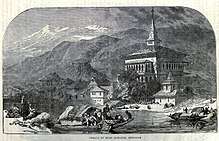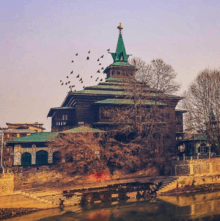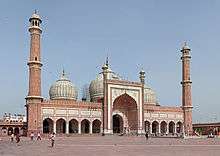Khanqah-e-Moula
Khanqah-e-Moula, also known as Shah-e-Hamadan Masjid and Khanqah is a mosque located in the Old City of Srinagar, Jammu and Kashmir, India. Situated on the right bank of the river Jhelum between the Fateh Kadal and Zaina Kadal bridges, it was first built in 1395 CE, commissioned by Sultan Sikendar. It is one of the best examples of Kashmiri wooden architecture, and is decorated with papier mache.[1] The mosque is alleged to stand atop the ruins of an ancient Hindu temple dedicated to goddess Kali.[2]
| Khanqah-e-Mu'alla | |
|---|---|
خانقاہِ معلّےٰ | |
The Khanqah on the banks of Jhelum | |
| Religion | |
| Affiliation | Islam |
| District | Srinagar |
| Region | Kashmir Valley |
| Ecclesiastical or organizational status | Active |
| Status | Active |
| Location | |
| Location | Fateh Kadal, Srinagar |
| State | Jammu and Kashmir |
| Country | India |
| Geographic coordinates | 34.091248°N 74.807771°E |
| Architecture | |
| Founder | Sultan Sikandar |
| Completed | 1395 CE, Rebuilt 1732 CE |
| Specifications | |
| Height (max) | 38m |
| Dome(s) | 1 (turret) |
| Minaret(s) | None |
Construction
The mosque was commissioned by Sultan Sikandar Butshikan in 1395 CE in memory of the Islamic preacher Mir Sayyid Ali Hamadani, the central figure involved in the widespread conversion to Islam in Kashmir. Also known as Shah-e-Hamadan (the King of Hamadan), the preacher came to Kashmir from the city of Hamadan in Persia in the 14th century. He is credited for the spread of Islam in Kashmir. In 1480 AD, the shrine was destroyed due to fire. The then ruler, Sultan Hassan Shah, expanded its premises and rebuilt it. In 1731 AD, the Khanqah was again destroyed by fire and then rebuilt by Abdul Barkat Khan.
Background

According to some sources, the current mosque structure was constructed after destroying an ancient temple dedicated to Hindu goddess Kali and a sacred Hindu site,[3] It is believed by some that Sayyid Ali Hamdani had the temple of Kali demolished and built the present mosque with its material.[4][5] and that a spring dedicated to Kali is still inside the mosque. The railing at the back of the mosque complex leads to a bright orange marking on the stone just below that suggests to the foundation belonging to the destructed Kali Shri temple.[6]Local Hindus were involved in various communal disputes and repeated altercations by 1942, agitating for the right to build a covered shrine adjacent to the Muslim shrine,[7] which eventually led to a boycott of Muslim-owned shops by Kashmiri Hindus.[8]
In ‘Eminent Personalities of Kashmir’, a book edited by a Kashmiri Hindu, Krishan Lal Kalla, mentions that according to Hindu belief, Khanqah was first the Kali temple. The book claims: “When Hazrat Ameer Kabir returned from Makkah, he went into the temple and offered his prayers. After he left the place, it was found that he had left footprints on that stone plate where he had bowed before the God. That temple was converted at once into Khanqah-e-Moula.[9]
However, others have questioned the validity of such claims, and believe it to be a revisionist attempt to re-cast history as traditional Kashmiri Hindu historians, such as Kalhana, Jonaraja and Shuk Bhatt make no mention of the existence of any temple at the site of the structure. The counterclaim stemming from the fact that a Hindu religious site also exists adjacent to the shrine and the historians have suggested that the two sites have in fact always been adjacent to one another,[9] their proximity being representative of communal tolerance.[10] Kashmiri Hindus have also historically held the Khanqah in high reverence.[11]
Archaeologist R.C. Kak in Ancient Monuments of Kashmir[12] and historian P. N. K. Bamzai in Culture and Political History of Kashmir while writing about the Khanqah, do not altogether mention anything about the possibility of the existence of a temple where the present structure stands.[13] Historian Ashiq Husain Bhat further argues that re-purposing of Hindu shrines into Muslim ones wouldn’t have been unusual, given that the overwhelming majority of Kashmiris converted to Islam, and a similar conversion of the site into a church would occur were Kashmiris to convert en masse to Christianity.[9] The construction of Muslim shrines at Hindu sites has also been interpreted by some as an attempt by Kashmiri Muslim to maintain links to their Hindu past.[14]
Adjacent Kali Shri Shrine
Toward the River Jhelum, there is a wall marked with Sindoor (or Sindooram, a traditional vermilion red or orange-red colored cosmetic powder from India, usually worn by married women along the parting of their hair) but not a temple and water oozes at a place, which Kashmiri Hindus say is dedicated to goddess Kali.[9][15]

Saleem Beg, a member of INTACH, states that the holy place of Hindus and the Khanqah co-existed together.[9]
Fire of 2017
On 15 November 2017, a fire broke out in the shrine which damaged the spire of the building. Fire tenders were brought on the scene and they managed to arrest the spread of the fire which prevented any further damage to the building.[16]
Restoration work was immediately started[17] and on 30 March 2018, a refurbished crown was successfully installed on the spire of the shrine.[18]
See also
| Wikimedia Commons has media related to Khanqah-e-Moula. |
References
- "Khanqah".
- Kaw, M. K. (2004), Kashmir and Its People: Studies in the Evolution of Kashmiri Society, APH Publishing, pp. 108–, ISBN 978-81-7648-537-1
- Kalla, Krishan Lal (1997). Eminent Personalities of Kashmir. Discovery Publishing House. ISBN 9788171413454.
- Kaw, M. K. (2004). Kashmir and Its People: Studies in the Evolution of Kashmiri Society. APH Publishing. ISBN 9788176485371.
- Koul, Mohan Lal (1 January 1999). Kashmir, Wail of a Valley. Gyan Sagar Publications. ISBN 9788186987384.
- Alkazi, Feisal (1 May 2014). Srinagar: An Architectural Legacy. Roli Books Private Limited. ISBN 9789351940517.
- Rai, Mridu (2004). Hindu Rulers, Muslim Subjects: Islam, Rights, and the History of Kashmir. Hurst. ISBN 9781850656616.
- Khan, Ghulam Hassan (1980). Freedom movement in Kashmir, 1931-1940. Light & Life Publishers.
- "Maha Kali temple co-exists with Khanqah". Rising Kashmir. Retrieved 15 January 2019.
- Iqbal, S. M.; Nirash, K. L. (1978). The Culture of Kashmir. Marwah Publications.
- Rabbani, G. M. (1986). Kashmir, social and cultural history. Anmol Publications.
- Kak, R.C. (2002). Ancient monuments of Kashmir (1st [reprint] ed.). Srinagar-190001, Kashmir: Gulshan Publishers. pp. 77–79. ISBN 81-86714-60-X.CS1 maint: location (link)
- Bamzai, P.N.K. (1994). Culture and Political History of Kashmir (1st ed.). New Delhi-110002: M.D. Publications. pp. 326–27, 536–40. ISBN 81-85880-33-6.CS1 maint: location (link)
- Central Asiatic Journal. O. Harrassowitz. 2010.
- Rai, Mridu (2004). Hindu Rulers, Muslim Subjects: Islam, Rights, and the History of Kashmir. Hurst. ISBN 9781850656616.
- "Khankah-e-Moula shrine damaged in Srinagar fire". 15 November 2017. Retrieved 5 May 2019.
- "Latest News From Kashmir, Breaking News, Current Headlines, Kashmir News Online | Greater Kashmir". Retrieved 5 May 2019.
- "Khankah-e-Maulla gets refurbished crown". 31 March 2018. Retrieved 5 May 2019.

